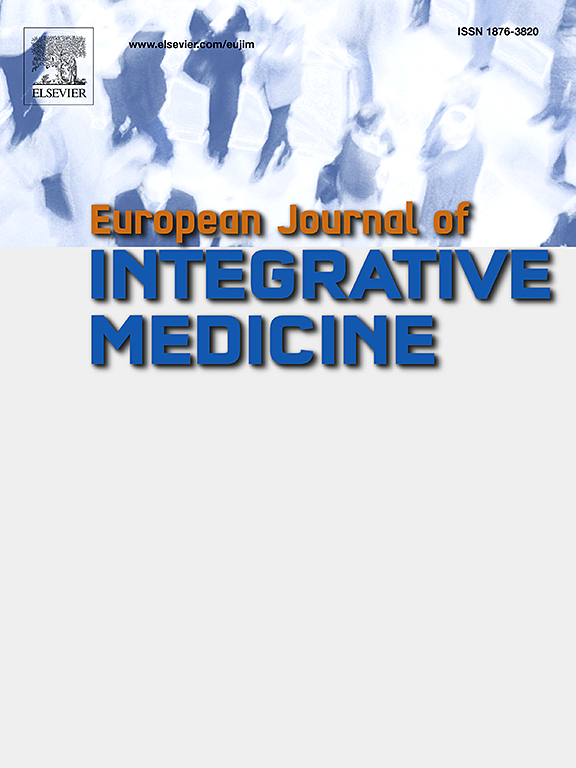Efficacy of dry cupping on urinary incontinence in women: A randomized controlled clinical trial
IF 1.7
4区 医学
Q3 INTEGRATIVE & COMPLEMENTARY MEDICINE
引用次数: 0
Abstract
Introduction
Urinary incontinence (UI) is a common condition that affects people of all ages worldwide and can lead to social isolation, low self-esteem, and depression if left untreated. The present randomized controlled clinical trial aimed to compare the efficacy of dry cupping and tolterodine in controlling UI in women.
Methods
The study included a total of 73 women, 36 in the dry cupping group and 37 in the tolterodine group. During the six week intervention, the tolterodine group received 2 mg of tolterodine twice daily, while the dry cupping group underwent two sessions of dry cupping in the right and left lower quadrant area every week. The severity of UI and the quality of life of patients were evaluated using the International Consultation on Incontinence Questionnaire—Urinary Incontinence Short Form (ICIQ-SF) and the Incontinence Quality of Life (IQOL) questionnaire at the beginning of the study, at weeks 3, 6, and 4 weeks after the end of the intervention (week 10).
Results
The results showed that UI symptoms improved significantly in the dry cupping group compared to the tolterodine group. According to ICIQ-SF, the effect of dry cupping on the total score (mean difference: -6.72, 95_% CI: -9.26 to -4.17), the frequency of urine leakage (mean difference: -1.52, 95_% CI: -2.18 to -0.85), and the quality of life (mean difference: -3.68, 95_% CI: -4.96 to -2.40) were significant throughout the study and the follow-up period, at week 10. No adverse events were reported.
Conclusion
Based on the results of the present study and considering the adverse events of the tolterodine use, dry cupping can be suggested as a therapeutic modality for women suffering from UI.
干罐治疗女性尿失禁的疗效:一项随机对照临床试验
尿失禁(UI)是一种影响全世界所有年龄段人群的常见疾病,如果不及时治疗,可能导致社会孤立、自卑和抑郁。本随机对照临床试验旨在比较干拔罐和托特罗定控制女性尿失禁的疗效。方法本研究共纳入73例女性,其中干拔组36例,托特罗定组37例。在6周的干预期间,托特罗定组给予托特罗定2 mg,每日2次,干拔组每周在左右下象限区域进行2次干拔。在研究开始时、干预结束后第3周、第6周和第4周(第10周),使用国际失禁咨询问卷-尿失禁短表(ICIQ-SF)和失禁生活质量(iol)问卷评估尿失禁的严重程度和患者的生活质量。结果与托特罗定组相比,干拔罐组尿失禁症状明显改善。根据ICIQ-SF,干拔罐对总评分(平均差值:-6.72,95% CI: -9.26至-4.17)、尿漏频率(平均差值:-1.52,95% CI: -2.18至-0.85)和生活质量(平均差值:-3.68,95% CI: -4.96至-2.40)的影响在整个研究和随访期间(第10周)均具有显著性。无不良事件报告。结论基于本研究结果,并考虑到托特罗定使用的不良事件,可建议干拔罐作为女性尿失禁的治疗方式。
本文章由计算机程序翻译,如有差异,请以英文原文为准。
求助全文
约1分钟内获得全文
求助全文
来源期刊

European Journal of Integrative Medicine
INTEGRATIVE & COMPLEMENTARY MEDICINE-
CiteScore
4.70
自引率
4.00%
发文量
102
审稿时长
33 days
期刊介绍:
The European Journal of Integrative Medicine (EuJIM) considers manuscripts from a wide range of complementary and integrative health care disciplines, with a particular focus on whole systems approaches, public health, self management and traditional medical systems. The journal strives to connect conventional medicine and evidence based complementary medicine. We encourage submissions reporting research with relevance for integrative clinical practice and interprofessional education.
EuJIM aims to be of interest to both conventional and integrative audiences, including healthcare practitioners, researchers, health care organisations, educationalists, and all those who seek objective and critical information on integrative medicine. To achieve this aim EuJIM provides an innovative international and interdisciplinary platform linking researchers and clinicians.
The journal focuses primarily on original research articles including systematic reviews, randomized controlled trials, other clinical studies, qualitative, observational and epidemiological studies. In addition we welcome short reviews, opinion articles and contributions relating to health services and policy, health economics and psychology.
 求助内容:
求助内容: 应助结果提醒方式:
应助结果提醒方式:


